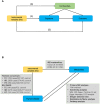Exploring blood metabolites and thyroid disorders: a bidirectional mendelian randomization study
- PMID: 37876541
- PMCID: PMC10591305
- DOI: 10.3389/fendo.2023.1270336
Exploring blood metabolites and thyroid disorders: a bidirectional mendelian randomization study
Abstract
Background: Human blood metabolites have demonstrated close associations with thyroid disorders in observational studies. However, it's essential to determine whether these correlations imply causation. Mendelian Randomization (MR) offers a promising approach to investigate these patterns.
Aims: The primary aim of our investigation is to establish causality between blood metabolites and three thyroid disorders: TC, GD, and HT.
Methods: We employed a two-sample bidirectional MR analysis approach to assess the relationships between 452 blood metabolites and the three aforementioned thyroid disorders. Causal links were estimated using the IVW method, with sensitivity analyses conducted via MR-Egger, Weighted Median, and MR-PRESSO. We assessed potential heterogeneity and pleiotropy using MR-Egger intercept and Cochran's Q statistic. Additionally, we conducted pathway analysis to identify potential metabolic pathways.
Results: We found 46 metabolites that showed suggestive associations with thyroid disease risk, especially Aspartate (ORIVW=7.41; 95%CI: 1.51-36.27; PIVW=0.013) and C-glycosyltryptophan (ORIVW=0.04; 95%CI: 0.00-0.29; PIVW=0.001) impacted TC, Kynurenine (ORIVW=2.69; 95%CI: 1.08-6.66; PIVW=0.032) and 4-androsten-3beta,17beta-diol disulfate 2 (ORIVW=0.78; 95%CI: 0.48-0.91; PIVW=0.024) significantly impacted GD, and Alpha-ketoglutarate (ORIVW=46.89; 95%CI: 4.65-473.28; PIVW=0.001) and X-14189-leucylalanine (ORIVW=0.31; 95%CI: 0.15-0.64 PIVW=0.001) significantly impacted HT. We also detected 23 metabolites influenced by TC and GD. Multiple metabolic pathways have been found to be involved in thyroid disease.
Conclusion: Our MR findings suggest that the identified metabolites and pathways can serve as biomarkers for clinical thyroid disorder screening and prevention, while also providing new insights for future mechanistic exploration and drug target selection.
Keywords: Mendelian randomization; autoimmune thyroid disease; bidirectional; metabolites; thyroid cancer.
Copyright © 2023 Zhang, Zhou, Xie, Li, Hu, He and Li.
Conflict of interest statement
The authors declare that the research was conducted in the absence of any commercial or financial relationships that could be construed as a potential conflict of interest.
Figures



References
Publication types
MeSH terms
Substances
LinkOut - more resources
Full Text Sources
Medical

